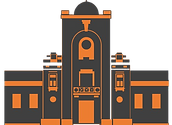


JOHOR BAHRU
View our current featured buildings

JOHOR BAHRU HERITAGE INVENTORY 2023

Johor Bahru (JB) is the capital city of the state of Johor. There are almost 1 million people of various ethnicity, background, and beliefs in JB. It is the gateway to Singapore through two major border checkpoints over the Straits of Johor. It is the second-largest urban agglomerate in Malaysia and among the top five in the world as the busiest international border crossing. JB is one of the fastest-growing cities in Malaysia after Kuala Lumpur.
Historically, JB was established in 1855 by Temenggung Daeng Ibrahim. At that time, Johor Bahru carried the name of Tanjung Puteri. Tanjung Puteri was later renamed Johor Bahru in 1862 and became the capital of the Johor Sultanate. When the late HRH Sultan Bakar became the ruler of Johor, he successfully turned JB into a modern city, which earned him the title of the Father of Modern Johor.
The late HRH Sultan Abu Bakar took upon many development projects such as administrative buildings, schools, religious buildings, and railways that connect JB with Woodlands in Singapore. One of the buildings built by the late HRH Sultan Abu Bakar in 1866 along the waterfront is his royal palace called Istana Besar, which presently turned into the Royal Abu Bakar Museum. The Johor- Singapore Causeway was constructed and opened in 1924. The British built a prominent Sultan Ibrahim building in 1940 to administer the Johor state.
Johor Bharu has been developing rapidly since the formation of Malaysia in 1963 and continues to link the whole peninsula to Singapore. As a nexus, JB is an ancillary city that provides transitional stations rather than an actual destination. Over the years, this situation led to the degradation of the central business district as more investments for development chose to operate outside the core district. The area around Wong Ah Fook Street, Tam Hiok Nee Street, and Dhoby Street used to be prosperous, and the hive is presently in dire need of redevelopment. However, this district is also rich with historical architecture embedded with rich layers of memory and heritage. Without intervention for conservation, the city heritage values might diminish, leading to a loss of opportunity for keeping heritage authenticity and meaning.
This inventory, therefore, aims to capture JB through photographic, video graphics, and photogrammetry for comprehensive archiving of the city. The archive is a record of the city and a reference to researchers, professionals, and the public for future development and conservation initiatives.
RESEARCHED ZONES

Legend
Zone 1
Zone 4
Zone 7
Zone 2
Zone 5
Zone 8
Zone 3
Zone 6
Zone 9
ARCHIstories OF JOHOR BAHRU




Bangunan Sultan Ibrahim
1939
Bangunan Sultan Ibrahim was constructed in 1936 and completed in 1940. The building design amalgamates Johor Malay, Islamic and colonial architecture. This building was the tallest in Malaya during the pre-independence era. During World War 2, the Japanese army occupied the building as their fortress and centre of operations to attack Singapore. There are carvings such as cloves and black pepper on the columns as symbols of the primary production of Johor state when the building was built. Formerly it served as the state secretariat building, state assembly hall, and the Chief Minister's office until 2009. Bangunan Sultan Ibrahim is a significant historical landmark in Johor Bahru.




Bank Negara Malaysia, Johor Bahru Branch
1975
Bank Negara Malaysia Johor Bahru Branch is one of the early modern landmarks built during the Post-Merdeka era. This building has been located at Jalan Duke since 1959. Brutalism Architecture influenced its design with features such as exposed concrete surfaces and imposing massing.




Broadway Cinema
1940s
The Broadway Cinema is located at Jalan Segget. Art Deco’s architectural style influenced the building’s design. The cinema faces the Segget River and connects to other historical shophouses along the street.




Former Johor Bahru Railway Station
1928
Built in 1931, the former Johor Bahru Railway Station is at Jalan Tun Abdul Razak. The building design was influenced by the Colonial rchitectural style. It has a striking symmetrical elevation with the main entrance under the central tower-like structure.
This railway station was built to replace the wooden built train station near the site, which has been operating since 1917. The historic railway station is now the first railway museum in Malaysia. Currently, the new Johor Bahru Sentral Station serves all the train services in Johor Bahru.



Gurdwara Sahib
1921
The Sikh society settled down in Johor State in the 19th century. Most of them were employed in the police force of the guard of Johor Sultan. The present site was gazetted as a temple reserved in 1921.
The original land was muddy and swampy, and thus the Sikhs filled up the ground using sand and stones to construct the first Sikh Gurdwara in late 1921. Later the second double-story Gurdwara building was built in 1956/1957. The present Gurdwara Sahib building was opened in 1992.




Johor Ancient Temple
1870
The Johor Chinese Ancient Temple was built in 1870 by the Johor Bharu's Chinese society led by Tan Hiok. This temple was the community centre of five different Chinese ethnic groups. In 1995, the temple underwent a renovation, but the original architectural characteristics were maintained. An annual event is held by the temple, namely Chingay, a parade of the deities around the Johor Bahru city centre. The temple hosts five deities worshipped by five different Chinese dialect groups, including Hokkien, Cantonese, Hainan, Teochew, and Hakka. This temple is a typical Chinese temple that adopts Chinese architectural characteristics.




Johor Bahru High Court
1929
The High Court building is located at Jalan Dato' Onn. It was built in 1929 as one of the administration buildings during the British colonial era. Neo-Classical architectural style influenced the building design. The building is still functioning today as the High Court of Johor Bahru.



Johor Bahru Post Office
1963
The Johor Bahru Post Office is one of the Post-Merdeka-era buildings in Johor Bahru. It is located at Jalan Dato' Onn, which sits adjacent to the City Council building.
The site of the Post Office formerly belongs to Johor Hotel. The Post Office building was designed with repetitive concrete fins, features of the International style architecture.




Johor Bahru State Police Headquarters
1928
The Central Police Station is located at Jalan Meldrum. This building was built in 1914 and influenced by British colonial architecture.




Kuil Arulmigu Rajamariamman Devasthanam
1911
Kuil Arulmigu Rajamariamman Devasthanam, or the Sri Raja Mariamman Temple Johor Bahru, is located at the corner where Jalan Trus and Jalan Ungku Puan meet. It is a typical South Indian Hindu temple. This Hindu temple pays homage to the goddess Mariamman, the deity of fertility and rain. The side of the temple facing Jalan Trus and Jalan Ungku Puan is lined with peddlers selling Hindu handicrafts and fresh flowers for worship. The current temple dates from the 1980s.




Masjid India
1950s
Masjid India is located at the junction of Jalan Duke and Jalan Dhoby, a mosque of the Indian Muslim community in Johor Bahru. Masjid India or currently known as Masjid Dato' Ahmad Awang, was started as a surau built in the 1950s on a piece of land donated by Dato Hj Abdul Majid bin Ahmadshah. Over the years, the Surau has been upgraded to Mosque status and become the official location for Friday prayer. The dome and minaret of the current building are designed with glass features which results in a modern appearance of the mosque.




Red House
19th Century
The Red House was a pre-war shophouse located at the junction of Jalan Tan Hiok Nee and Jalan Pahang. It is believed an Indian family was the original owner. This building design was influenced by the Straits' Eclectic architectural style. The building has a roof with Chinese rounded clay tiles, a decorative facade, traditional tiles for the ground floor, and a timber structure for the first floor.
Jalan Tan Hiok Nee was named after a trader of clothing, pepper, and gambier named Tan Hiok Nee. The road commemorates Teochew society and his contribution to Johor during Sultan Abu Bakar's era. Jalan Tan Hiok Nee connects the commercial area at Jalan Wong Ah Fook and Jalan Dato' Onn, where the city council building is located. Currently, the road serves as a cultural street that preserved the history and culture of Chinese society in Johor Bahru.




Salahuddin Bakery
1937
Salahuddin Bakery is one of the oldest bakeries in Johor Bahru. The bakery has used the historical wood-fired oven in the shop to produce cakes, bread, and other pastries since 1937.
It sits along Jalan Dhoby, which is one of the historical streets that existed in the Johor Bahru city centre. The shophouses along the street were built from the 1930s until the 1950s.


Segget River
Based on the historical records, the Segget River is named after a sluice Gate, a homonym of "Sea Gate". It is about 4.28km long and flows through the downtown of Johor Bahru, and ends at the Straits of Johor.
The Segget River flows through the east bank and the west bank of the river and forms a small shaped triangle island called Segget Island. The geographical conditions led to the unique layout of the shophouses along Jalan Segget. Once, the river was dirty and smelly due to pollution and flow under the road. Sungai Segget underwent a revitalisation project, and now, the Segget River is adorned with hardscape and soft scape. The landscape is divided into three sections, which are the historical and heritage zone, the culture and arts zone, and the fun and leisure zone. The newly revitalised Sungai Segget successfully rejuvenated the area and provided an opportunity for more activities in the city centre.
JOHOR CAUSEWAY

Johor-Singapore Causeway
Straits of Johor | 1924
As the second largest state in Peninsular Malaysia which located at the south of Peninsular, Johor has a unique development history as it is one of the states in Malaya that was colonized by the British. Sultan Abu Bakar moved the capital of Johor from Telok Belanga to Johor Bahru in 1866 and later in 1895, the throne of the Johor state was succeeded by his son, Sultan Ibrahim. The Johor Causeway was built during his reign. The construction of the causeway had recorded its own unique history and its existence affected the economy, politics and society of the state of Johor in particular and Malaysia in general.
In 1917, it was decided that such link between Malaya and Singapore was needed. 17 million was spent on constructing the Causeway, which is located in Woodlands and spans the Straits of Johor. The cost was shared between the Federated Malay States, the Straits Settlements and the State of Johor. The granite bank, 1.056km in length and 18m in width, accommodated a double railway track, a road and a foot way. Most of the granite used was quarried at Bukit Timah and Pulau Ubin. In September 1923, the Causeway was first opened to traffic in the form of goods train. On 28th June 1924, the Johor Causeway was inaugurated by Sultan Ibrahim together with the British High Commissioner, Governor Sir Laurence Guillemard and also the Sultans of Federated Malay States.
In 18th March 2020, the causeway was shut down due to Movement Control Order (MCO) in response to the Covid-19 pandemic. Only food supplies and other necessity goods were allowed to go through the Causeway. The Causeway was fully reopened again without any restrictions on 1st April 2022.





















